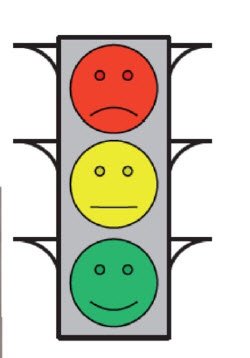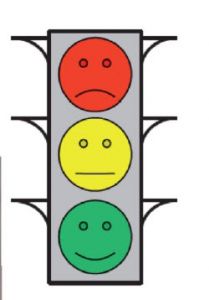Disentangling roles
Background
A new scientific paper aims to help disentangle the role of sea lice on the marine survival of Atlantic salmon (https://academic.oup.com/icesjms/article/75/1/50/3867702). It is worth highlighting the beginning of the paper’s abstract:
‘The effects of sea lice in the marine survival of wild salmonids are widely debated. In Norway this debate has reached a crescendo as the Norwegian Government has recently ratified a management system where the growth in the salmonid aquaculture industry will be conditional on regional estimated impact of salmon lice on wild fish. Sea lice has thus become the most prominent obstacle to the stated political aim of quintupling aquaculture production in Norway by 2050. Scientific documentation that salmon lice impact the marine survival of salmon is robust. However, it is also evident that marine survival of salmon is strongly impacted by other factors and that the effect of salmon lice is most likely an integral part of these mortality factors.’ We will discuss some of the points raised in this extract throughout this commentary.
Also, in the news, the local Government in British Columbia has taken what it believes to be a significant step towards defending wild salmon against the array of threats allegedly posed by open pen salmon farms. Whether licences are granted to farms will be dependent on the views of the local First Nations and on proof that the farms will not damage wild salmon populations. This is the latest development against salmon farming by the anti-salmon farming lobby, who have managed to persuade many of the First Nation people that salmon farming is to blame for declines in the number of returning wild salmon.
The tangled web
The disentangling sea lice paper is authored by a total of sixteen scientists – twelve of whom are Norwegian, three are from Canada and one from the USA. This is not the first paper in which some of these scientists have worked together. For example. Three of the Norwegians and two of the Canadians also worked on the major Norwegian ‘MetaLice’ study in 2014. This was a comparison of the results of many studies of smolts treated with an anti-parasitic agent compared with smolts that had been untreated. This is very similar work to that of the SARF project which we have recently discussed.
One of the two Canadians is Martin Krkosek, who is currently based at the University of Toronto. Martin has previously featured in issues of reLAKSation. He first came to our attention when independent researcher Vivian Krause commented on a press release from the David Suzuki Foundation in 2005 that claimed: ‘fish farms cause sea lice abundances thousands of times higher than natural levels.’ When Vivian looked at the original work, she noticed that the study didn’t actually measure sea lice levels at a salmon farm. In fact, during part of the research, there were no fish in the farm referred to in the study. According to Vivian, when Martin Krkosek, then of the University of Alberta, later gave testimony to a public hearing of the BC Government, he admitted that his findings were all correlative. A correlation does not show cause, yet the study generated hundreds of media stories around the world implicating salmon farming in the decline of wild salmon stocks.
Martin Krkosek came again to prominence in 2007 when researchers from the University of Alberta, where he was then based, and the Salmon Coast Field Station warned that if outbreaks of sea lice continued at the same rate, the local population of wild pink salmon would be extinct within four salmon generations. This warning was published in the journal ‘Science’ and again received widespread publicity. CBC News reported that Krkosek had used a mathematical model of population growth rates to show that salmon lice from farms were driving wild pink salmon towards extinction.
Martin Krkosek’s colleague in this research was salmon farming critic and activist Alexandra Morton. She told the Cohen Commission in 2010 that sea lice might have contributed to the collapse of the Fraser River sockeye salmon stock in 2009.
However, as Business Vancouver points out, pink salmon stocks in the Broughton Archipelago didn’t collapse but surged dramatically in 2014. Fraser River sockeye also made a stunning comeback with a return of 28 million fish in 2010 and a return of 19 million four years later.
Krkosek and Morton’s response to these resurgent stocks is that their prior warnings had been heeded, however, Dick Beamish, a retired fisheries scientist from the Pacific Biological Station made it clear that the abundance of pink salmon is not affected by those salmon farms, ‘no matter what anyone says’.
In 2014, Martin Krkosek was back in the news after he published a critic of the work of Dave Jackson from Ireland’s Marine Institute. Writing in the Journal of Fish Diseases, he claimed that Dave Jackson’s work had statistical errors and other faults. The Marine Institute challenged Krkosek’s account and issued a rebuttal, which the journal published. They also downgraded Krkosek’s work to an opinion piece rather than a peer reviewed paper. According to the Irish Times, the Journal of Fish Diseases apologised to the Marine Institute for inadequate editorial procedures. Dave Jackson had found that sea lice from salmon farms had only a minimal impact on wild fish stocks, which clearly did not fit in with Martin Krkosek’s view of how salmon farms relate to wild salmon.
In the same year, Martin Krkosek was busy collaborating with a team of ten other scientists on the MetaLice project. This was a review and a meta-analysis of all Norwegian studies in which 118 different groups of salmon smolts were released having been selected as a control or for treatment with an anti-parasitic agent.
The main conclusion of the study was that a treated fish has an increased chance of returning over control fish of 18%. This assumes that the effect of treating smolts with an anti-parasitic agent protects the fish against sea lice and that recapture reflects survival. The researchers concluded that the study gives unequivocal evidence to the hypothesis that salmon lice is a contributor to the mortality of wild salmon.
MetaLice revisited
The MetaLice study, which has helped form some of the policy on sea lice in Norway has recently become of renewed interest. This follows publication of the interim SARF report in Scotland, which details a smolt release trial using wild caught salmon smolts, rather than ranched. The study was not a great success because only two fish, out of nearly 4,000 smolts that had been released, were recaptured on their return to the River Lochy on Scotland’s west coast.
However, to bulk out their report, the researchers plotted raw data from the MetaLice study onto a graph. This showed for each of the 118 separate releases, whether more treated smolts than control fish returned or vice versa. The aim was to see where the Norwegian returns compared to those recorded in Scotland. The recapture rate from the River Lochy was so small that it is impossible to see on the graph, however the SARF researchers can take solace from the fact that several of the Norwegian releases failed to recapture any fish at all. The Scottish study was repeated on the east coast where there are no salmon farms. More fish were recaptured than on the west coast, but it was the control group that showed the biggest return.
When the individual Norwegian releases are plotted on a graph, as Marine Scotland Science have done, it is apparent that only two of the releases recaptured as many as 18% of the released fish. All the others are well below this figure including those where the controls exceeded the treated groups and therefore are recorded as negatives. Given the small number of releases with this higher difference between treated and control it is hard to understand how the researchers concluded that on average a treated fish has an 18% increased chance of being recaptured than the untreated fish. It must be due to the type of statistical analyses used in this study.
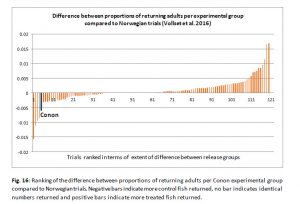
The lead author of the MetaLice study, Knut Wiik Vollset, kindly sent us a copy of the raw data allowing us the opportunity to take another approach to the analysis. The 118 studies, which ran from 1996 to 2012, were not all the same, as some used different treatments, some different recapture methods and some involved different research groups. Direct comparison can therefore be extremely difficult. Instead we have added up the numbers of fish released, and the numbers of fish recaptured.
In total, 326,475 fish were released as controls and 331,149 fish were treated and released. The number of controls recaptured was 1,849 and the number of treated fish recaptured was 2,140. Added together, this means that about 0.6% of the released fish were recaptured. The numbers are so small that it is impossible to conduct any real assessment of lice impact. However, the difference between the two groups is less than 1% which equates to the findings of Dave Jackson and his team.
Due to the very small numbers of fish that returned there is clearly something else other than lice that is affecting the survival of the wild salmon. Despite the claims made by the Metalice researchers, sea lice are not the problem for Norwegian wild salmon.
Wild salmon status
By coincidence, the Norwegian Expert Group on wild salmon (Vitenskapelig Rad for Lakseforvaltning (VRL)) have just issued their annual report on the status of Norwegian salmon. VRL consists of a group of thirteen Norwegian scientists who are holding their position from 2017 to 2020. The group was previously formed from other scientists whose term of membership has now come to an end. Of the current thirteen, three are listed as authors on the paper about disentangling the role of sea lice. This illustrates how the small group of specialist scientists in Norway work together.
Jan Arve Gjøvik of Aquablogg.no has commented on the VRL report and he points out that the graphs in the report show that the stock of wild Norwegian salmon has remained relatively unchanged over the last 25 years. Over the same period, salmon farming has increased from just under 200,000 tonnes to over 1.2 million tonnes. Dr Gjøvik rightly points out that despite a formidable increase in farmed salmon production, wild salmon production has remained relatively stable. Yet, the conclusion of the report is that salmon farming remains the biggest threat to wild salmon in Norway.
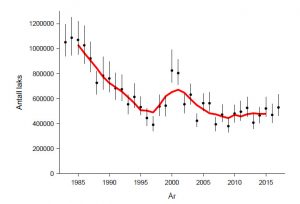
In case Dr Gjøvik has exhibited any bias in his overview of the status of the Norwegian wild salmon stock, Torbjørn Forseth from NINA, who currently heads VRL, told Intrafish.no that the salmon stock is at a stable low level. He also says that the salmon stock has halved over the last thirty years but fails to mention that according to their graph the decline lasted just ten years, up to the early 1990’s Since then, as he points outs, the stock has remained relatively stable. Dr Forseth’s comments came in an article that concerned the former head of the Norwegian Directorate for Nature Management, Janne Sollie who warned in 2009 that wild salmon would be extinct in Norway within five to ten years. This is something that has clearly not happened.
Even though the size of the wild salmon stock has remained stable for many years, VRL have concluded that the three biggest threats to wild salmon come from the aquaculture industry. These threats are escaped salmon, salmon lice and other fish diseases. Torbjørn Forseth says that the risk from escapes has been reduced from ‘very high’ to ‘high’ as less fish are now escaping. He adds that the other diseases are also a threat because knowledge of how they impact on wild fish is poor.
Jan Arve Gjøvik points out that VRL have summarised the threats to wild salmon in graphical form since 2010. Dr Gjovik says that it is unclear how VRL have calculated where the risk appears in the graph however he suggests that perhaps the location of each risk on the graph has little to do with the science and more to do with the desire to implicate the salmon industry. The question is why would VRL want to do that? Dr Gjøvik says to ‘follow the money’. He suggests that researchers have for many years had access to virtually unlimited funding to investigate and find evidence for the impacts of salmon farming and the decline of wild salmon stocks. Their continued research is encouraged by 100,000 salmon anglers and many river owners together with a media that believes in the myths created by researchers. It is unlikely that any researcher is going to admit that sea lice are not the problem if it means an end to the ‘gravy train’.

Closing the circle
Martin Krkosek’s involvement in developing the narrative in which salmon farming is implicated in the decline of wild salmon stocks seems to have increased with his participation in collaborative research with a number of Norwegian institutions. What interests us is not his contribution to any of the findings per se, but rather his personal connections.
Martin Krkosek has a website in which he describes his work on population ecology and its applications to epidemiology, fisheries and conservation (http://krkosek.eeb.utoronto.ca/). His work is on marine fishes, marine mammals, aquatic parasites, mathematical models and statistical analysis. The website also describes that fieldwork is undertaken at the Salmon Coast Field Station on the British Columbian coast.
We have already mentioned the Salmon Coast Field Station in this commentary. Their website describes how the Field Station was originally Alexandra Morton’s home after she moved to the area to study orcas. The website says that she noticed that resident orcas had abandoned the area and she blamed this on the presence of salmon farms in the locality. Her concern grew as to the impact of these salmon farms on the local ecosystems, so she began to invite graduate students into her home to gather information and raise awareness about the ‘lice epidemic’ on wild salmon. Martin Krkosek was one of these graduate students.
Martin Krkosek and Alexandra Morton are now both directors of the Salmon Coast Field Station. If there was any doubt about the relationship between Krkosek and Alexandra Morton, his website includes links to several articles and newspaper reports about Alexandra Morton’s campaigns against salmon farming. These include:
https://thetyee.ca/News/2016/07/25/Sea-Lice-Young-Salmon/
https://www.bbc.co.uk/news/uk-scotland-highlands-islands-20236291
Martin Krkosek’s also lists his associates at the University of Toronto on the website and surprisingly amongst the list is Knut Wiik Vollset of Uni Research in Bergen. This connection is of interest because Dr Vollset is also the lead author of the MetaLice study as well as the paper about disentangling the role of sea lice. Dr Vollset has just returned from two weeks in British Columbia, which included time at the Salmon Coast Field Station. It is also worth mentioning that one of the other Canadians listed on the disentangling paper is Andrew Bateman, who is also a board member of the Salmon Coast Field Station along with Martin Krkosek and Alexandra Morton.
The links between Alexandra Morton, The Salmon Coast Field Station, Martin Krkosek, Andrew Bateman and the group of Norwegian researchers, who are helping shape policies on Norwegian salmon farming must be of concern, not least because of recent events in Canada but because the links are not very transparent. At the same time, the salmon farming industry is getting the blame for impacts of which it may be not guilty.
Back in December 2016, the Norwegian Government asked the Institute of Marine Research (IMR), the Veterinary Institute (VI) and the Norwegian Institute of Nature Research (NINA) to form an expert group to assess the impact of sea lice on wild fish. Seemingly, the invitation was not extended to anyone from the salmon farming industry. The group consisted of ten scientists two of whom were involved in the MetaLice study and authored the disentanglement paper. One was Bengt Finstad, who also co-authored the report commissioned by Salmon & Trout Conservation Scotland and Knut Wiik Vollset. The beginning of their report includes an image of a traffic light, leaving nothing else to be said.
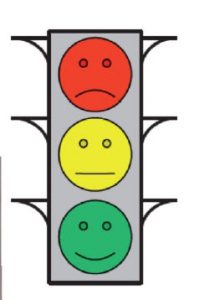
Any debate?
Finally, we would like to pick up on the comments made in the abstract of the disentanglement paper. This said that the debate about sea lice had reached a crescendo in Norway. This is not our experience. In fact, we have found an unwillingness to enter into any debate at all. Some readers might remember that we discussed the ICES meeting in Copenhagen in 2016 where Norwegian researchers were only interested in discussing their own views and had no interest in discussing those from anyone else.
We recently sent a copy of the book, Loch Maree’s Missing Sea Trout, to the leaders of VRL, Dr Torbjørn Forseth and Dr Eva Thorstad, both from NINA. Although the book focusses on sea trout, its theme is very much the impact of salmon farming on wild fish. Dr Thorstad’s response was that ‘I am sorry that I have to decline your review request. I do reviews for editors of scientific peer reviewed journals and books. But unfortunately, I do not have the time and resources to meet private review requests’. Notwithstanding that she was only asked what she thought of the book as a way of initiating discussion and at no time was she asked for a review, Dr Thorstad was clearly not interested in considering other sides of the debate. He colleague Dr Forseth was more straightforward with his reply – ‘ikke interessert’.
Far from reaching a crescendo, it seems debate about sea lice in Norway is non-existent. It is very difficult to challenge any claims about salmon farming, if those scientists making such claims simply refuse to talk.

